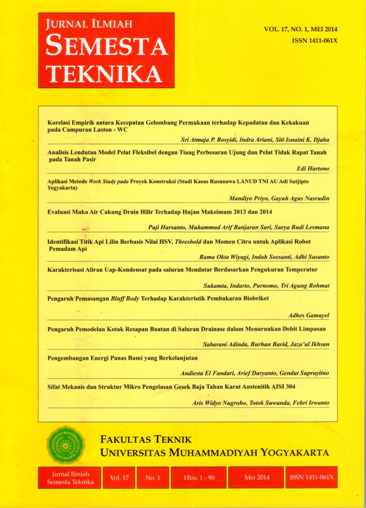Pengaruh Pemodelan Kotak Resapan Buatan di Saluran Drainase terhadap Debit Limpasan
DOI:
https://doi.org/10.18196/st.v17i1.411Abstract
Drainage isasewer system in an areathat serves todrain excess rainfall. Initially, an artificial drainage channel could absorb water because the drainage channel is made from landorland with grass. Negative impacts frequently occurrence on the channel walls that are eroded by water see page. While the current drainage channel is impermeable, making direct runoff flows rapidly into water bodies. Land use is increasingly impermeable resulting bigger runoff and causing negative impacts, such as floods and decreasing groundwater savings due to rainfall directly flows into water bodies orriver nearby. In this paper, authortried tomake adrainage channel innovation by making boxes infiltration along the concrete channel. The aim of the study is to determine the effect of artificial recharge box modeling along drainage channels in reducing runoff using wastel and and grintinggrass(Cynodondactylon) media, determine the ratio of absorptionability between box wastel and media and Grinting grassmedia in reducing runoff using concrete channel/watertight as a reference. The model is made of wood with the size of 750×30×20cm and 5catchment box made every distance of 100cm along the channel, then the water flowed into the channel for an hour, and velocity data taken every five minutes before and after the flow through the box and also water level data taken every five minutes. The result shows that artificial recharge box with wasteland media can reduce runoff entering the channel, with the ability to reduce runoff at first hour about of 38.322% and it will decrease every hour, on it is smallest on the fourth hour 4 about of 28.038%. Also, a model with grintinggrass media can reduce runoff and the largestefficiency value is about 49.744% in first hour. Channel modeling with artificial recharges box using grinting grass media is better than only using wasteland for reducing.
Downloads
Published
How to Cite
Issue
Section
License
Semesta Teknika is licensed under a Creative Commons Attribution 4.0 International License.
Authors who publish with this journal agree to the following terms:
- Authors retain copyright and grant the journal right of first publication with the work simultaneously licensed under a Creative Commons Attribution License that allows others to share the work with an acknowledgement of the work's authorship and initial publication in this journal.
- Authors are able to enter into separate, additional contractual arrangements for the non-exclusive distribution of the journal's published version of the work (e.g., post it to an institutional repository or publish it in a book), with an acknowledgement of its initial publication in this journal.
- Authors are permitted and encouraged to post their work online (e.g., in institutional repositories or on their website) prior to and during the submission process, as it can lead to productive exchanges, as well as earlier and greater citation of published work (See The Effect of Open Access).









